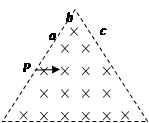问题
选择题
在一个边界为等边三角形的区域内,存在一个方向垂直于纸面向内的匀强磁场,在磁场边界上的P点处有一个粒子源,发出比荷相同的三个粒子a、b、c(不计重力)沿同一方向进入磁场,三个粒子通过磁场的轨迹如图所示,用ta、tb、tc分别表示a、b、c通过磁场的时间;用ra、rb、rc分别表示a、b、c在磁场中的运动半径,则下列判断正确的是

A.ta=tb>tc
B.tc>tb>ta
C.rc>rb>ra
D.rb>ra>rc
答案
AC
出射点为a、b的粒子在磁场中转过的圆心角相同,运动时间 ,因为粒子比荷相同,所以运动时间相同,即ta=tb,根据几何关系可知从c点射出的粒子转过的圆心角较小,则运动时间也较短,所以ta=tb>tc,故A正确B错误
,因为粒子比荷相同,所以运动时间相同,即ta=tb,根据几何关系可知从c点射出的粒子转过的圆心角较小,则运动时间也较短,所以ta=tb>tc,故A正确B错误
根据几何关系可知,出射点为a的粒子在磁场中运动半径,小于出射点为b的粒子在磁场中的运动半径,出射点为b的粒子在磁场中的运动半径,小于出射点为c的粒子在磁场中的运动半径,即. rc>rb>ra,故C正确D错误
故选AC
